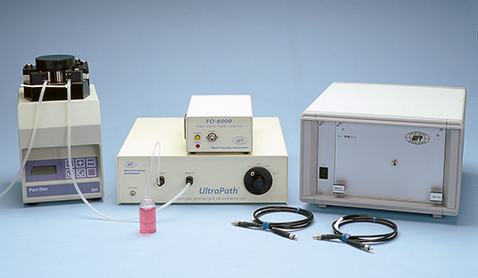Analyzing Water's Optical Absorption
A cooperative agreement between World Precision Instruments (WPI), Inc., of Sarasota, Florida, and NASA's Stennis Space Center has led to a new innovation that benefits both NASA and the general scientific community. After a collaboration with Dr. Richard Miller, a NASA chief scientist and biological oceanographer, WPI is marketing its UltraPathTM device, which provides a more efficient method for analyzing the optical absorption of water samples at sea.
Dr. Miller, who conducts research aboard ships around the globe to support NASA's satellite programs, initiated the development of UltraPath. He collects water samples to verify observations from space by examining colored dissolved organic matter (CDOM), a major component of land runoff that affects ocean color in coastal waters. Since the presence of CDOM complicates the detection of other materials using ocean color sensors, measuring how much light CDOM absorbs helps scientists to evaluate the accuracy of products developed from satellite imagery. The standard method of measuring the absorption of water samples requires special handling and storage. According to Dr. Miller, the procedure involves freezing the seawater samples and shipping them to a laboratory for spectral analysis.
To avoid this time-consuming and costly process, Dr. Miller teamed with WPI, an international manufacturer of laboratory equipment, to develop a portable, yet robust, system. Dr. Miller gained financial support for the UltraPath project through a dual-use cooperative agreement between Stennis' Office of Technology Transfer and WPI. The company's recognized expertise in the field of liquid waveguide capillary cell technology (LWCCTM) served as a platform for UltraPath's design. Dr. Mathias Belz, senior scientist for the company, stated, "The [Technology Transfer's] Dual-Use program has provided both partners with the opportunity to combine NASA's vast knowledge of oceanology with WPI's expertise in optical instrumentation, resulting in the successful design of UltraPath."
On a technical note, UltraPath is a unique, high-performance absorbance spectrophotometer with user-selectable light path lengths of 2, 10, 50, and 200 cm. It is an ideal tool for any study requiring precise and highly sensitive spectroscopic determination of analytes, either in the laboratory or in the field. The instrument operates in the wavelength range of 370 nanometers (nm) to 725 nm and has a dynamic range allowing reliable absorbance measurements between 5 micro absorbance units per centimeter (mAU/cm) to 1 absorbance unit per centimeter (AU/cm).
As a low-cost, rugged, and portable system capable of high-sensitivity measurements in widely divergent waters, UltraPath meets Dr. Miller's needs while providing commercial opportunities for WPI. Dr. Miller explained, "The flexibility of the system solves a critical problem for oceanographers and opens the door to numerous other applications." The product will help scientists examine the role that coastal ocean environments play in the global carbon cycle.
UltraPath™ is a trademark of World Precision Instruments, Inc.
LWCC™ is a trademark of World Precision Instruments, Inc.

The innovative UltraPath™ is a “multiple pathlength” optical system.













